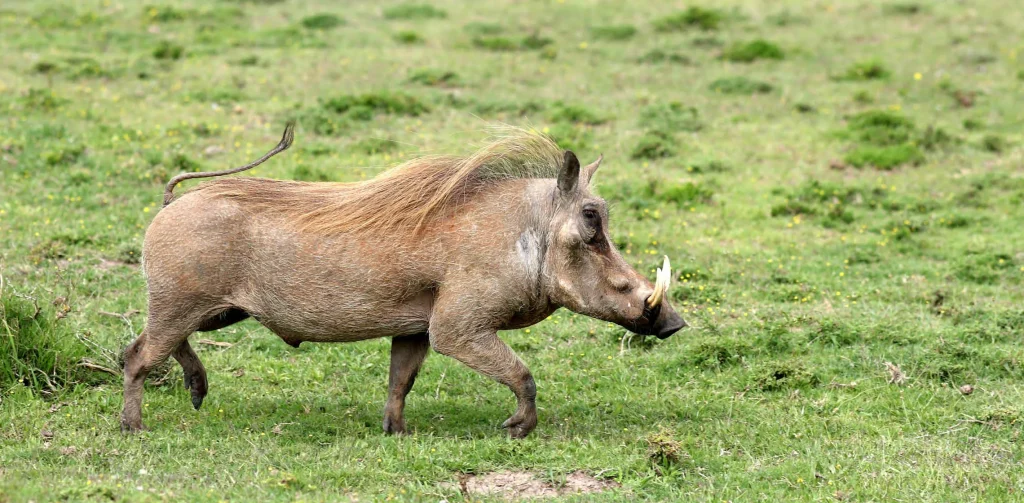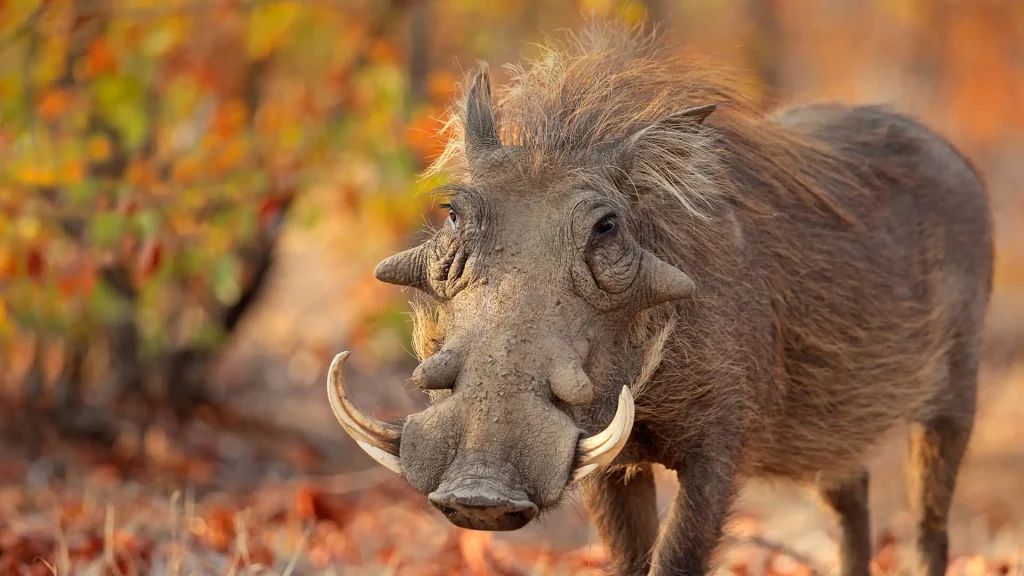What are Warthogs? Wondering what those quirky animals with the characteristic tusks and bristly manes are? Come along and discover the amazing world of warthogs!

What are Warthogs?
Throughout sub-Saharan Africa, warthogs are wild pigs with scanty hair. These unusual creatures have long, thin tails that they keep straight when running, huge heads and bodies, small legs, and coarse manes down the backs.
Their name comes from the huge, wart-like pimples on their faces, which are their most distinguishing characteristics.
When warthogs battle, which happens between males during mating season, these fleshy growths help protect their faces and eyes.
In order to detect potential dangers when grazing, these warts are also covered in small hairs that enable them detect vibrations in the ground.
Warthogs are also renowned for having two sets of tusks: a pair of upper tusks that form a semicircle 60 centimeters (two feet) long, and a pair of long, protruding lower tusks that measure around 15 centimeters (six inches) each which are utilized during combat.
Species of Warthog
The common warthog, which is widely distributed, and the desert warthog are the two species of warthogs. Common warthogs are distributed throughout Sub-Saharan Africa in open plains, grassland savannahs, and forests.
They differ from their desert cousins in that they have larger tusks and longer manes. In contrast, desert warthogs are better suited to the drier climate of semi-arid areas of Ethiopia, Kenya, and Somalia because they have longer legs and less body fat.
What is a Warthog’s Scientific Name?
Phacochoerus, the scientific name for a warthog, is derived from the Greek words phakos, which means “wart,” and khoiros, which means “pig” or “hog.”
Every warthog species has a distinct scientific name as well. Phacochoerus africanus is the name of the common warthog, and Phacochoerus aethiopicus is the name of the desert warthog.
READ ALSO:
- What Do Axolotls Eat?
- Do Narwhals Still Exist?
- Is A Tarsier A Monkey?
- Why Is Duck-Billed Platypus A Mammal?
Aethiopicus and Africanus allude to the regions in which each species is found, respectively, and both names represent its ancestry. The Suidae family of pigs includes both varieties of warthogs.
Where Do Warthogs Live?
In sub-Saharan Africa, the common warthog lives in forests, grassland savannahs, and open plains. They can be found in the majority of nations, from South Africa to the Sahara Desert.
The semi-arid areas of Kenya, Ethiopia, and Somalia in East Africa are home to desert warthogs. Locals refer to the abandoned aardvark burrows where warthogs reside as “aardvark hotels.”
Females reside in communal groupings of up to 40 people, known as “sounders.” These sounders cluster together for warmth at night and share burrow complexes.
Although they let young males dwell with them, adult males are primarily solitary and have separate territories.
Fun Facts About Warthogs
Warthogs are often regarded as endearing and amusing creatures due to their distinctive bristly manes and tusks. However, these ungulates are far more complex than cartoonish representations would lead us to suppose.
These animals are remarkable due to their unique habits, adaptations, and ecological duties.
Let’s investigate the world of warthogs and discover some surprising facts about these intriguing creatures.
1. There Are Two African Warthogs
The common warthog (Phacochoerus africanus) and the desert warthog (Phacochoerus aethiopicus) are found in Tanzania. These two species differ mostly in how they have adapted to their various surroundings.
The common warthog is well-suited to both wet and dry environments, and its range extends over diverse African landscapes. The desert warthog, on the other hand, is limited to dry areas.
2. Warthogs Don’t Really Have Warts
The “warts” on the face that give warthogs their name are really thick skin growths rather than worts. The appearance and distribution of the so-called warts are not consistent.
They are thought to provide defense when fighting with other males or predators. They are seen on the face, especially around the eyes. The warthog’s hard skin and its warts on its face can help prevent scratches or bites.
3. Warthogs Utilize Abandoned Burrows
Warthogs use burrows that have been left by other animals, especially aardvarks, as opposed to many mammals which dig their own dens.
These burrows’ main purposes are to protect the animals from the elements and, more importantly, to give a safe haven from lions, leopards, and hyenas.
It’s interesting to note that warthogs retreat inside their burrows to protect themselves from possible invaders.
4. Warthogs Like to Get Muddy
Warthogs frequently roll in the mud, which is a multipurpose activity. Thermoregulation is the first. The thick mud in the African savanna serves as a natural cooler during the hot weather.
A coating of mud grows over the skin as it dries, deflecting the sun’s rays and offering long-lasting relief. Warthog skin is susceptible to sunburn, therefore the mud also serves as a natural sunscreen.
Finally, mud helps control parasites. Ticks, fleas, and other parasites that may have adhered to the warthog’s skin are carried away when it dries and peels off.
5. Warthog Tusks Are Teeth
Their tusks are arguably what set warthogs apart from other animals. Throughout the animal’s life, these structures—which are essentially extended upper and lower canine teeth—continue to grow.
The more noticeable upper pair can grow up to 25 inches (64 centimeters) in length. Despite being smaller, the lower set is crisper.
Both tusks are employed for protection against rivals and predators as well as for digging for roots and tubers.
6. They Have a Bunch of Babies
Although litters of up to eight piglets have been documented, warthog litters normally consist of two to six piglets.
Compared to other ungulates, these newborns are born with their eyes open and a comparatively high level of development.
They can follow their mother out of the burrow to feed and acquire vital survival abilities at an early age thanks to this early development.
In the sounder, sows frequently nurse and shield piglets from other family groups. Warthogs are incredibly fascinating animals because of their unusual activities and remarkable appearance.
Warthogs provide an insight into the astounding diversity of the animal kingdom through their social nature, digging skills, varied diet, and defensive strategies.
These mysterious ungulates are crucial to their ecosystems because they aid in soil aeration and seed distribution.
Our understanding of warthogs’ role in the natural world grows as we learn more about them. Thus, the next time you see a warthog, pause to enjoy these amazing creatures and their special characteristics.

